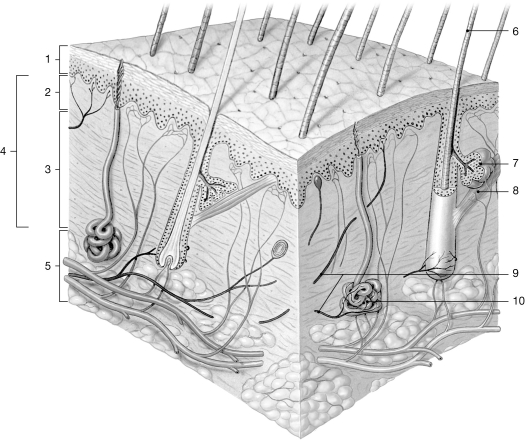A) nail root.
B) lunula.
C) nail bed.
D) free edge.
E) hyponychium.
Correct Answer

verified
Correct Answer
verified
Multiple Choice
All of the following are true of the pigment melanin, except that it
A) is produced by cells called melanocytes.
B) protects DNA from the damaging effects of UV radiation.
C) increases with increased levels of the hormone MSH.
D) decreases in concentration within cells during exposure to the sun.
E) is usually some shade of brown or black.
Correct Answer

verified
Correct Answer
verified
Multiple Choice
Jaundice is indicated by
A) an orange skin coloration.
B) a reddish skin coloration.
C) a bluish skin coloration.
D) a yellowish skin coloration.
E) a brown skin coloration.
Correct Answer

verified
Correct Answer
verified
Multiple Choice
 Figure 5- 1 The Components of the Integumentary System
Use Figure 5- 1 to answer the following questions) :
-Which tissue is located in the region labeled "2"?
Figure 5- 1 The Components of the Integumentary System
Use Figure 5- 1 to answer the following questions) :
-Which tissue is located in the region labeled "2"?
A) adipose tissue
B) reticular connective tissues
C) cartilage and blood
D) stratified squamous epithelium
E) areolar connective tissue
Correct Answer

verified
E
Correct Answer
verified
Short Answer
A fibrin clot that is formed over a skin wound is called an)______
Correct Answer

verified
Correct Answer
verified
Multiple Choice
Glands that discharge an oily secretion into hair follicles are _____ glands.
A) apocrine sweat
B) mammary
C) sebaceous
D) ceruminous
E) merocrine sweat
Correct Answer

verified
Correct Answer
verified
Multiple Choice
Water loss from insensible perspiration
A) is negligible.
B) is approximately 0.5 liter a day.
C) always exceeds sensible perspiration.
D) is too small to be measured reliably.
E) depends on apocrine sweat glands.
Correct Answer

verified
Correct Answer
verified
Multiple Choice
The_____ glands in the axilla become active at the time of puberty.
A) apocrine sweat
B) merocrine sweat
C) axillary
D) ceruminous
E) sebaceous
Correct Answer

verified
Correct Answer
verified
Multiple Choice
Lanugo is found
A) on the palms of the hands.
B) on the soles of the feet.
C) on the scalp.
D) on a fetus.
E) both C and D
Correct Answer

verified
Correct Answer
verified
Multiple Choice
Water loss due to evaporation of fluid that has penetrated through the skin is termed _____perspiration.
A) active
B) sensible
C) insensible
D) latent
E) inactive
Correct Answer

verified
Correct Answer
verified
Multiple Choice
Which of the following is not an effect of ultraviolet radiation?
A) wrinkles
B) chromosomal damage in germinative cells or melanocytes
C) production of cholecalciferol within epidermal cells
D) increased activity by melanocytes
E) vitiligo
Correct Answer

verified
Correct Answer
verified
Multiple Choice
At the base of a nail, keratinized skin called the cuticle is also called the
A) lunula.
B) eponychium.
C) hyponychium.
D) cerumen.
E) phalanx.
Correct Answer

verified
Correct Answer
verified
Multiple Choice
Each of the following is a function of the integumentary system, except
A) protection of underlying tissue.
B) maintenance of body temperature.
C) synthesis of vitamin C.
D) excretion of salts and wastes.
E) provision of sensation.
Correct Answer

verified
Correct Answer
verified
Short Answer
Provide one beneficial effect of exposure to ultraviolet UV) radiation
Correct Answer

verified
It stimulates synthesis of vitamin D3.
Correct Answer
verified
Multiple Choice
The layer of hard keratin that coats the hair is termed the
A) root.
B) hair bulb.
C) cuticle.
D) medulla.
E) shaft.
Correct Answer

verified
Correct Answer
verified
Short Answer
______ are accumulations of fluid within the epidermis or between the epidermis and the dermis.
Correct Answer

verified
Blisters
Correct Answer
verified
Matching
Match the term with its key characteristic.
Correct Answer
Short Answer
A deficiency disease that illustrates the effect of integumentary system function on the structure of the skeletal system is ________.
Correct Answer

verified
Correct Answer
verified
Multiple Choice
Nail production occurs at the nail
A) hyponychium.
B) cuticle.
C) root.
D) body.
E) bed.
Correct Answer

verified
Correct Answer
verified
Multiple Choice
Which of the following statements about rickets is not true?
A) is usually genetic
B) prevented by sunlight
C) leads to weak bones
D) leads to skeletal deformity
E) prevented by vitamin D
Correct Answer

verified
Correct Answer
verified
Showing 1 - 20 of 93
Related Exams